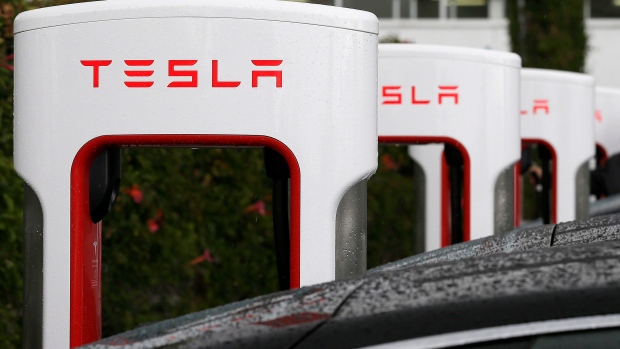Mar 28, 2018
'Shorts are piling in': Tesla plunges second day amid questions around fatal crash
, Bloomberg News

Tesla Inc. shares dropped for a second day as questions swirl about what caused a crash involving a Model X crossover in California on Friday, an accident that killed the driver and intensified the pressure mounting on Elon Musk’s electric-car maker.
The company hasn’t been able to retrieve the vehicle’s logs and is working with authorities to do so, according to a blog post. Tesla preemptively defended the record of the Autopilot safety features that it’s said will eventually enable autonomous driving, without disclosing whether the driver involved the fatal crash had engaged the system before the incident.
Tesla declined as much as 6.6 per cent to US$260.89 Wednesday, the lowest in a year. The company’s unsecured bonds have also dropped to all-time lows ahead of the release of first-quarter production and deliveries results expected next week.
The crash, investigated by U.S. authorities, adds to Chief Executive Officer Musk’s challenges including concerns that the electric-car maker won’t reach its production targets for the all-important Model 3 sedan. The accident also potentially raises fresh questions about self-driving features after a deadly Uber Technologies Inc. accident that happened days earlier sent ripples across the broader autonomous-vehicle industry.
The U.S. National Transportation Safety Board said Tuesday it was sending investigators to examine issues raised by the Tesla accident, in which the Model X struck a highway barrier on March 23 near Mountain View. The safety board will examine the post-crash fire and steps needed to make the vehicle safe to remove from an accident scene, according to a tweet.
Tesla owners have driven the same highway stretch with Autopilot engaged about 85,000 times since the system was introduced, and no accidents have been reported that the company is aware of, the carmaker said.
Battery Design
Tesla’s battery packs are designed so that when a fire occurs, it spreads slowly so people have more time to exit the car. “That appears to be what happened here as we understand there were no occupants still in the Model X by the time the fire could have presented a risk,” the company said in its blog post.
The collision caused extensive damage partly because a safety barrier meant to reduce the impact into a concrete lane divider had been removed or crushed in a prior accident without being replaced, according to Tesla.
The safety board is also investigating the Uber accident in Tempe, Arizona, in which a Volvo XC90 equipped with the ride-hailing giant’s self-driving system failed to slow the vehicle as a 49-year-old woman crossed the street pushing a bicycle. The pedestrian died from the collision.
The safety board’s investigation into the Tesla crash is the second this year involving the company’s vehicle.
“There’s just so much bad news right now,” John Thompson, the chief executive officer of Vilas Capital Management LLC, which is shorting Tesla shares, said by phone. “You’ve got the NTSB investigating a new crash, Nvidia suspending autonomous testing, and Tesla can’t make the Model 3. When the stock goes lower like this, it gets harder to raise capital. It’s going to be harder for them to raise money.”
Moody’s Investors Service downgraded Tesla’s corporate family rating to B3, six levels into junk, and said its outlook on the company is negative. The credit rater cited “the significant shortfall in the production rate of Tesla’s Model 3” and liquidity pressures as two chief concerns.
“The negative outlook reflects the likelihood that Tesla will have to undertake a large, near-term capital raise in order to refund maturing obligations and avoid a liquidity short-fall,” Moody’s analysts wrote.
Lofty Goals
Model 3 deliveries have fallen short of Musk’s lofty goals since the company started building it in July. Bloomberg’s Model 3 tracker estimates the company may be making about 975 of the cars a week, well short of the target to build at a 2,500-unit rate by the end of this quarter.
An analyst at Citigroup Inc. wrote Tuesday that Tesla may be struggling to convert car shoppers into Model 3 buyers, while Robert W. Baird & Co. said Monday the company might not achieve its weekly production goal by the end of March.
“This is the most negative sentiment I’ve seen in a while,” Ben Kallo, an analyst at Baird, said Tuesday. “It’s really about the Model 3 production and ramp up, and the shorts are piling in.”



